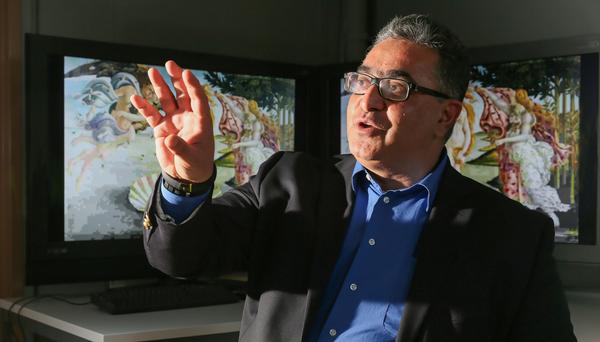"JPEG changed our world"

© 2014 EPFL
JPEG is the image format we use the most in the world, be it in our computers, smartphones or digital cameras. But it is actually more than that. JPEG is also an international group of experts, which recently elected as its head an EPFL Professor: Touradj Ebrahimi. The new President sheds light on the JPEG adventure and gives us an overview of new features in development.
Four letters, over twenty years in existence and a virtual world monopoly in image compression. The JPEG standard, which is used more than one billion times each day on social networks alone, recently elected as its Head the EPFL professor Touradj Ebrahimi. At its core, what is the significance of JPEG? Touradj Ebrahimi gives us an overview of this popular standard that has revolutionized our lives.
JPEG is everywhere. The basis of this project, however, was laid out over 30 years ago...
This is true. JPEG is an image format created to address a major problem in the digital age. In the early 80s, no technology existed to copy or transmit electronic images. Minitel, invented by the French, only allows you to send text and simple graphics. We had to find a way to reduce the size of image files. It was the international standardization groups and telecommunications industry that provided the impetus for the creation of JPEG. In 1982, they brought world experts in image compression to the table to form the "Joint Photographic Experts Group (JPEG)." The JPEG format was created in 1992.
How does JPEG reduce image file sizes more that other formats?
Basically, JPEG relies on a lossy compression algorithm. When an image is compressed in JPEG, a portion of its contents is destroyed, but practically without being noticeable to the human eye. This technique makes it possible to reduce the image file size, so that it can be easily stored, copied and transmitted. Over the years, other formats with various technologies have been developed, such as JPEG2000, which can operate with or without loss. Lossless compression is used mainly in the medical settings, where it is crucial to preserve image details. The JPEG group is also working on a new standard called JPEG XT, which will allow efficient compression of High-Dynamic-Range images with a wide color gamut.
Why has JPEG become a global standard?
At the time of the emergence of Internet and digital devices, JPEG was the only international standard that was fre e and accessible to all. While other commercial compression formats were offered by private companies (e.g.: Kodak), JPEG was the only partially open format, suitable for all devices and software, requiring no royalties. Another reason for this success is that new JPEG formats, such as JPEG XT, are developed so as to be always readable with an old version of JPEG. It's important not to rush the consumers, because they do not like abrupt changes. The proof is that after 22 years of existence, JPEG has strengthened and is increasingly popular.
e and accessible to all. While other commercial compression formats were offered by private companies (e.g.: Kodak), JPEG was the only partially open format, suitable for all devices and software, requiring no royalties. Another reason for this success is that new JPEG formats, such as JPEG XT, are developed so as to be always readable with an old version of JPEG. It's important not to rush the consumers, because they do not like abrupt changes. The proof is that after 22 years of existence, JPEG has strengthened and is increasingly popular.
If everything is open and free, what's the point of working on the development of standards such as JPEG?
There are several. When a format is free, developers and consumers are more inclined to use it. If it is also open source, it means that everybody can access the details of the algorithm, and try to improve it. For scientists, it is therefore easier to analyse the strengths and weaknesses of the approach, and to propose new ideas to improve it.
What are your next challenges as President of JPEG?
Before the end of 2015, we plan to finalize the new JPEG XT format, for an efficient compression of High-Dynamic-Range (HDR) images, which are increasingly widespread. JPEG XT contains enough information to correct the shot when a picture taken by a digital camera is under-exposed or over-exposed resulting in a too dark or too bright image. Then, for the years 2015-2020, we will launch the basis of a new version of JPEG called JPEG Pleno, in reference to the term "plenoptic." The idea is to correct the focus of a picture after it has been taken, and to make any object in the image sharper even if it appears blurred in the initial picture. It will also be possible to look at any object in the picture, even from a different perspective than what the camera that captured it..
Why is image transmission so important to human beings?
To have value and meaning, an image must be shared and copied. Since the dawn of time, humans have sought to transmit images, whether by painting on cave walls, by copying illustrations manually or by mechanically reproducing them with the invention of the printing press. The instrument of JPEG is part of this mission of transmission, but this time in digital form. It has changed our world. Today, almost everyone has used JPEG, whether via computer, smartphone, tablet or camera. And yet, most of the time, people don't really know what it is.
How do you predict our relationship with images will evolve in the future?
I hope JPEG Pleno can last for 20 to 30 years. Then, in my opinion, we will progress towards a point at which it's no longer necessary to go through the eye to access images. Images could for example be injected directly into the brain!
----
More information and latest press release here: www.jpeg.org